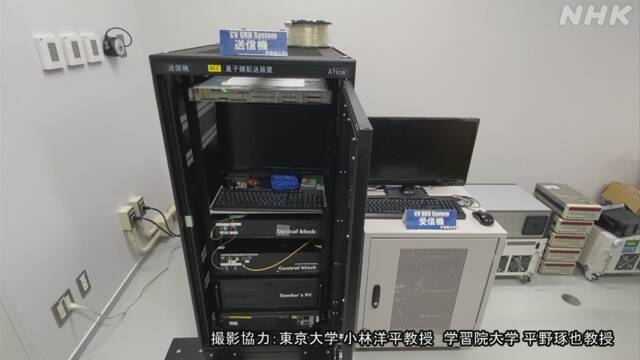
The University of Tokyo: Developed a new low-cost signal processing method: “Quantum cryptography”
-The University of Tokyo succeeded in development-
Quantum cryptography:
It dramatically improves the security of Internet communication.
We have developed a “breakthrough low-cost new signal processing method” for the next-generation cryptographic communication technology “quantum cryptography”.
Problems with the current method:
Currently, the “method of transmitting signals by placing signals on photons” is mainly used.
In the current method, it is necessary to keep the environment at a negative temperature in order to handle extremely small grains.
However, the equipment is expensive to maintain at low temperatures.
Solution, devised new signal processing method:
A research group at the University of Tokyo has devised a “new signal processing method using special functions” in “quantum cryptography”.
At room temperature without using photons,
A method that uses the light waves of an optical fiber
To be able to have the same strength as cryptography
Demonstrated for the first time in the world.
This research result:
It was published in the British scientific journal “Nature Communications” published on January 13th.
IT / Net | NHK News
https://www3.nhk.or.jp/news/html/20210113/k10012812731000.html
The University of Tokyo: Solving the security problem of quantum cryptography that measures light waves
-Advance to lower cost of quantum cryptography equipment-
January 13, 2021
Summary of announcement
◆ Conventional problems
Quantum cryptography detects photons, but “a method of measuring the amplitude of light waves instead” has been studied.
However, there was a big wall that “the theory that guarantees security is incomplete”.
◆ This time, we devised a new method
Eavesdropping traces obtained by detecting photons,
From only the analog measurement result of amplitude
Invented a new method to accurately estimate the trace of eavesdropping,
Resolved a security issue.
◆ Realized at low cost
Compared to the photon detector, the amplitude measuring device can be realized at low cost and compactly.
It has a high affinity with existing optical communication technologies such as wavelength division multiplexing.
It is expected that the spread of quantum cryptography technology will be promoted.
This research group:
Solved the security problem of quantum cryptography that measures light waves.
Without making unrealistic assumptions
With guaranteed security
The specific method of communication,
We found it for the first time.
Identifying eavesdropping traces by wave amplitude:
Find the trace of eavesdropping from the “analog amount of wave amplitude”.
The idea of a new method was the key to the solution.
Due to this result
Cost reduction of quantum cryptography
Compactification of quantum cryptography equipment,
Optical wavelength division multiplexing (Note 3), etc.
It will open the way to large capacity.
For the spread of quantum cryptography technology with strong security. It gives a lot of momentum.
Nihon Keizai Shimbun
https://www.nikkei.com/article/DGXLRSP602973_S1A110C2000000/
Nature Communications volume 12,
Finite-size security of continuous-variable quantum key distribution with digital signal processing
Nature Communications
Abstract
In comparison to conventional discrete-variable (DV) quantum key distribution (QKD),
continuous-variable (CV) QKD with homodyne/heterodyne measurements
has distinct advantages of lower-cost implementation and affinity to wavelength division multiplexing.
On the other hand, its continuous nature makes it harder
to accommodate to practical signal processing, which is always discretized, leading to lack of complete security proofs so far.
Here we propose
a tight and robust method of estimating fidelity of an optical pulse to a coherent state via heterodyne measurements.
We then construct a binary phase modulated CV-QKD protocol and prove its security in the finite-key-size regime against general coherent attacks, based on proof techniques of DV QKD.
Such a complete security proof is indispensable for exploiting the benefits of CV QKD.